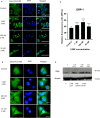Regulation of mitochondrial dynamics in 2-methoxyestradiol-mediated osteosarcoma cell death
- PMID: 33452331
- PMCID: PMC7811003
- DOI: 10.1038/s41598-020-80816-x
Regulation of mitochondrial dynamics in 2-methoxyestradiol-mediated osteosarcoma cell death
Abstract
Osteosarcoma (OS) is one of the most malignant tumors of childhood and adolescence. Research on mitochondrial dynamics (fusion/fission) and biogenesis has received much attention in last few years, as they are crucial for death of cancer cells. Specifically, it was shown that increased expression of the cytoplasmic dynamin-related protein 1 (Drp1) triggers mitochondrial fission (division), which activates BAX and downstream intrinsic apoptosis, effectively inhibiting OS growth. In the presented study, human OS cells (metastatic 143B OS cell line) were incubated with 2-methoxyestradiol (2-ME) at both physiologically and pharmacologically relevant concentrations. Cell viability was determined by the MTT assay. Confocal microscopy and western blot methods were applied to examine changes in Drp1 and BAX protein levels. Mitochondrial Division Inhibitor 1, MDIVI-1, was used in the study to further examine the role of Drp1 in 2-ME-mediated mechanism of action. To determine quantitative and qualitative changes in mitochondria, electron microscopy was used. 2-ME at all used concentrations increased mitochondrial fission and induced autophagy in OS cells. At the concentration of 1 µM 2-ME increased the area density of mitochondria in OS cells. Subsequent, upregulated expression of Drp1 and BAX proteins by 2-ME strongly suggests the activation of the intrinsic apoptosis pathway. We further observed 2-ME-mediated regulation of glycolytic state of OS cells. Therefore, we suggest that changes of mitochondrial dynamics may represent a novel mechanism of anticancer action of 2-ME. This finding may open new approaches to improve the efficacy of chemotherapy in the treatment of OS, however, it has to be confirmed by in vivo studies.
Conflict of interest statement
The authors declare no competing interests.
Figures






Similar articles
-
Mdivi-1 ameliorates early brain injury after subarachnoid hemorrhage via the suppression of inflammation-related blood-brain barrier disruption and endoplasmic reticulum stress-based apoptosis.Free Radic Biol Med. 2017 Nov;112:336-349. doi: 10.1016/j.freeradbiomed.2017.08.003. Epub 2017 Aug 5. Free Radic Biol Med. 2017. PMID: 28790012
-
Mitochondrial division inhibitor 1 reduces dynamin-related protein 1 and mitochondrial fission activity.Hum Mol Genet. 2019 Jan 15;28(2):177-199. doi: 10.1093/hmg/ddy335. Hum Mol Genet. 2019. PMID: 30239719 Free PMC article.
-
Anticancer Potential of Oleuropein, the Polyphenol of Olive Oil, With 2-Methoxyestradiol, Separately or in Combination, in Human Osteosarcoma Cells.Anticancer Res. 2019 Mar;39(3):1243-1251. doi: 10.21873/anticanres.13234. Anticancer Res. 2019. PMID: 30842154
-
To mdivi-1 or not to mdivi-1: Is that the question?Dev Neurobiol. 2017 Nov;77(11):1260-1268. doi: 10.1002/dneu.22519. Epub 2017 Aug 30. Dev Neurobiol. 2017. PMID: 28842943 Free PMC article. Review.
-
The Regulatory Mechanisms of Dynamin-Related Protein 1 in Tumor Development and Therapy.Cancer Biother Radiopharm. 2021 Feb;36(1):10-17. doi: 10.1089/cbr.2020.3791. Epub 2020 Aug 6. Cancer Biother Radiopharm. 2021. PMID: 32762544 Review.
Cited by
-
ADCK1 is a potential therapeutic target of osteosarcoma.Cell Death Dis. 2022 Nov 12;13(11):954. doi: 10.1038/s41419-022-05401-8. Cell Death Dis. 2022. PMID: 36371387 Free PMC article.
-
Estrogen metabolites and hydrogen peroxide - Missing elements in the pathophysiology and possible treatment of treatment-resistant depression?Redox Biol. 2025 Apr;81:103547. doi: 10.1016/j.redox.2025.103547. Epub 2025 Feb 20. Redox Biol. 2025. PMID: 40068329 Free PMC article.
-
Targeting the mitochondrial protein YME1L to inhibit osteosarcoma cell growth in vitro and in vivo.Cell Death Dis. 2024 May 20;15(5):346. doi: 10.1038/s41419-024-06722-6. Cell Death Dis. 2024. PMID: 38769124 Free PMC article.
-
CKB affects human osteosarcoma progression by regulating the p53 pathway.Am J Cancer Res. 2022 Oct 15;12(10):4652-4665. eCollection 2022. Am J Cancer Res. 2022. PMID: 36381321 Free PMC article.
-
2-Methoxyestradiol Damages DNA in Glioblastoma Cells by Regulating nNOS and Heat Shock Proteins.Antioxidants (Basel). 2022 Oct 12;11(10):2013. doi: 10.3390/antiox11102013. Antioxidants (Basel). 2022. PMID: 36290736 Free PMC article.
References
-
- Ciruzzi MS. To mdivi-1 or not to mdivi-1: is that the question? Arch. Argent. Pediatr. 2018;116:365–367. - PubMed
Publication types
MeSH terms
Substances
LinkOut - more resources
Full Text Sources
Other Literature Sources
Research Materials
Miscellaneous

